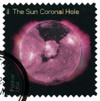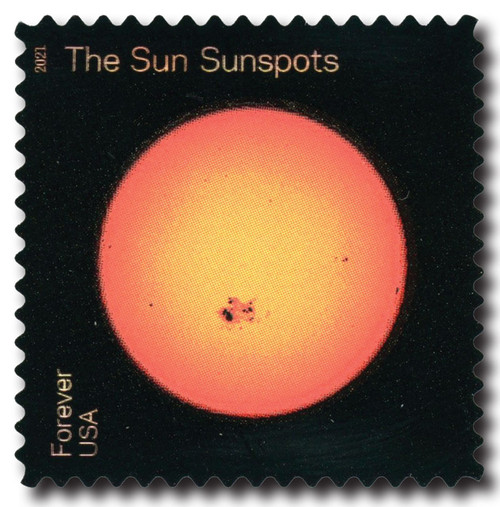
# 5598 - 2021 First-Class Forever Stamp - Sun Science: Coronal Hole
US #5598
2021 Coronal Hole – Sun Science
- Pictures a coronal hole on our sun
- One of 10 stamps in the Sun Science set
Stamp Category: Commemorative
Set: Sun Science
Value: 55¢ First Class Mail Rate (Forever)
First Day of Issue: June 18, 2021
First Day City: Greenbelt, Maryland
Quantity Issued: 18,000,000
Printed by: Banknote Corporation of America
Printing Method: Flexographic, Foil Stamping
Format: Panes of 20
Tagging: Phosphor, block tag
Why the stamp was issued: To showcase the powerful and mysterious science behind the functioning of our sun.
About the stamp design: Pictures a colorized images from NASA’s Solar Dynamics Observatory of a coronal hole. According to NASA, the color of this stamp represents an image of the sun as viewed with “211 Angstrom light, a wavelength of extreme ultraviolet light. This type of light is invisible to our eyes and is absorbed by Earth’s atmosphere, so it can only be seen by instruments in space.”
First Day City: The First Day of Issue Ceremony was held at Greenbelt Main Post Office. It was originally to be held at the NASA Goddard Space Flight Center, but was moved due to observance of the Juneteenth Federal Holiday and the facility being closed.
About the Sun Science set: Includes 10 stamp designs picturing different details of our sun along with phenomena associated with it. Each design pictures a colorized image from NASA’s Solar Dynamics Observatory. The different colors represent a different wavelength that reveals or highlights a particular aspect of our sun.
History the stamp represents: Our Sun is classified as a G-type main-sequence star, also known as a red-orange-yellow star. Many stars in this category are the same size as our Sun, though there are also smaller and larger examples. Regardless of size, G-type main-sequence stars have surface temperatures that fluctuate from 5,300 to 6,000 degrees Kelvin. That’s equal to about 9,000 to 10,000 degrees Fahrenheit!
All the heat and energy produced by G-type main-sequence stars are created by the same reaction. Deep inside the core of these stars, nuclear fusion is taking place. In this reaction, hydrogen atoms are forced together to form new helium atoms. Our Sun completes this reaction at an astounding rate – about 600 million tons of hydrogen is transformed into helium every second. Four million tons of matter is converted into energy during this process.
Nuclear reactors on Earth create energy through the opposite process – fission, which splits atoms instead of joining them. While this still creates a huge amount of energy, it is nowhere near the amount produced by nuclear fusion. However, because of the massive cost of creating a productive nuclear fusion reactor, scientists have not yet been able to make this dream a reality. It puts into perspective just how valuable the power from our sun really is.
US #5598
2021 Coronal Hole – Sun Science
- Pictures a coronal hole on our sun
- One of 10 stamps in the Sun Science set
Stamp Category: Commemorative
Set: Sun Science
Value: 55¢ First Class Mail Rate (Forever)
First Day of Issue: June 18, 2021
First Day City: Greenbelt, Maryland
Quantity Issued: 18,000,000
Printed by: Banknote Corporation of America
Printing Method: Flexographic, Foil Stamping
Format: Panes of 20
Tagging: Phosphor, block tag
Why the stamp was issued: To showcase the powerful and mysterious science behind the functioning of our sun.
About the stamp design: Pictures a colorized images from NASA’s Solar Dynamics Observatory of a coronal hole. According to NASA, the color of this stamp represents an image of the sun as viewed with “211 Angstrom light, a wavelength of extreme ultraviolet light. This type of light is invisible to our eyes and is absorbed by Earth’s atmosphere, so it can only be seen by instruments in space.”
First Day City: The First Day of Issue Ceremony was held at Greenbelt Main Post Office. It was originally to be held at the NASA Goddard Space Flight Center, but was moved due to observance of the Juneteenth Federal Holiday and the facility being closed.
About the Sun Science set: Includes 10 stamp designs picturing different details of our sun along with phenomena associated with it. Each design pictures a colorized image from NASA’s Solar Dynamics Observatory. The different colors represent a different wavelength that reveals or highlights a particular aspect of our sun.
History the stamp represents: Our Sun is classified as a G-type main-sequence star, also known as a red-orange-yellow star. Many stars in this category are the same size as our Sun, though there are also smaller and larger examples. Regardless of size, G-type main-sequence stars have surface temperatures that fluctuate from 5,300 to 6,000 degrees Kelvin. That’s equal to about 9,000 to 10,000 degrees Fahrenheit!
All the heat and energy produced by G-type main-sequence stars are created by the same reaction. Deep inside the core of these stars, nuclear fusion is taking place. In this reaction, hydrogen atoms are forced together to form new helium atoms. Our Sun completes this reaction at an astounding rate – about 600 million tons of hydrogen is transformed into helium every second. Four million tons of matter is converted into energy during this process.
Nuclear reactors on Earth create energy through the opposite process – fission, which splits atoms instead of joining them. While this still creates a huge amount of energy, it is nowhere near the amount produced by nuclear fusion. However, because of the massive cost of creating a productive nuclear fusion reactor, scientists have not yet been able to make this dream a reality. It puts into perspective just how valuable the power from our sun really is.













